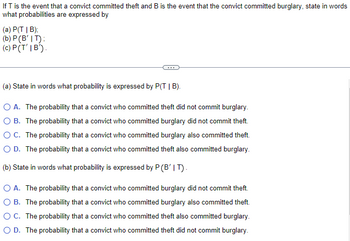
A First Course in Probability (10th Edition)
10th Edition
ISBN: 9780134753119
Author: Sheldon Ross
Publisher: PEARSON
expand_more
expand_more
format_list_bulleted
Question
I need help with this

Transcribed Image Text:If T is the event that a convict committed theft and B is the event that the convict committed burglary, state in words
what probabilities are expressed by
(a) P(TIB);
(b) P (B' IT);
(c) P(T'IB').
(a) State in words what probability is expressed by P(TIB).
O A. The probability that a convict who committed theft did not commit burglary.
O B. The probability that a convict who committed burglary did not commit theft.
O C. The probability that a convict who committed burglary also committed theft.
O D. The probability that a convict who committed theft also committed burglary.
(b) State in words what probability is expressed by P (B' IT).
O A. The probability that a convict who committed burglary did not commit theft.
O B. The probability that a convict who committed burglary also committed theft.
OC. The probability that a convict who committed theft also committed burglary.
O D. The probability that a convict who committed theft did not commit burglary.

Transcribed Image Text:(c) State in words what probability is expressed by P (T' | B').
O A. The probability that a convict who committed burglary did not commit theft.
O B. The probability that a convict who did not commit theft also did not commit burglary.
O C. The probability that a convict who did not commit burglary also did not commit theft.
O D. The probability that a convict who committed theft did not commit burglary.
Expert Solution
This question has been solved!
Explore an expertly crafted, step-by-step solution for a thorough understanding of key concepts.
Step by stepSolved in 5 steps

Knowledge Booster
Similar questions
Recommended textbooks for you
 A First Course in Probability (10th Edition)ProbabilityISBN:9780134753119Author:Sheldon RossPublisher:PEARSON
A First Course in Probability (10th Edition)ProbabilityISBN:9780134753119Author:Sheldon RossPublisher:PEARSON

A First Course in Probability (10th Edition)
Probability
ISBN:9780134753119
Author:Sheldon Ross
Publisher:PEARSON
